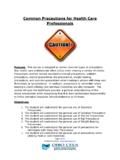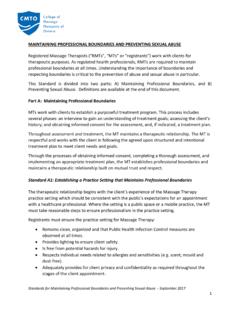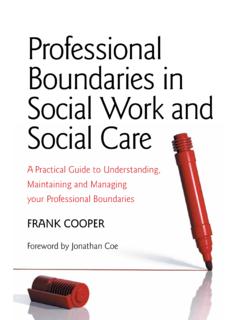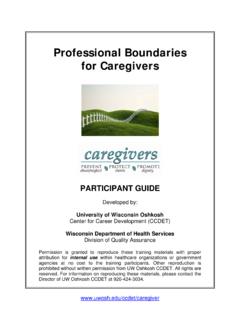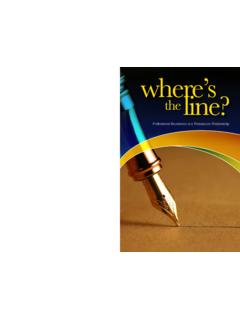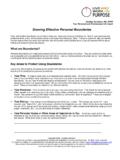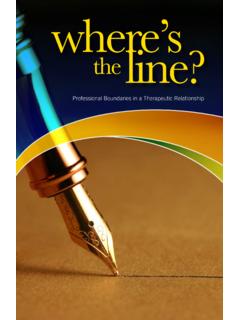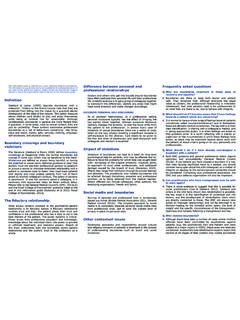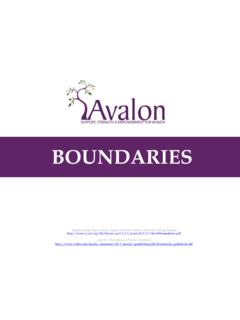Transcription of Establishing and Maintaining Ethical Professional …
1 Establishing and Maintaining Ethical Professional boundaries I) Course Purpose This course will discuss Professional boundaries in both clinician-client relationships and colleague-colleague interactions. It will address ethics issues, the benefits of Professional boundaries and common mistakes made with regard to Establishing and Maintaining these standards. It will also provide tips for how to sustain ethically-driven relationships with clients and colleagues. This course was written for a variety of healthcare disciplines. II) Course Objectives Define Professional boundaries Discuss Ethical foundations for Professional boundaries Examine the importance of Professional boundaries in client relationships Examine the importance of boundaries in colleague relationships Discuss common lapses made when Establishing Professional boundaries Provide tips in how to maintain Professional boundaries III) Course Outline I) Course Purpose II) Course Objectives III) Course Outline IV) Course Content A) Introduction B) What are Professional boundaries ?
2 Page 1 of 26. 2010 Ohio CEUS C) Ethics and Professional boundaries D) Professional boundaries in Client Relationships E) Boundary Lapses with Clients F) Professional boundaries in Colleague Relationships G) Boundary Lapses with Colleagues H) Professional Boundary Tips I) Conclusion V) Works Cited VI) Post Test IV) Course Content A) Introduction In our healthcare roles, we encounter numerous individuals throughout the day, week or year in various work settings. Whether we are Therapists, Nurses, Counselors, Social Workers, Activity Directors or other health professionals, it is imperative that we apply the upmost standards of conduct to all of our working relationships. One way of assuring this is by Establishing and Maintaining healthy Professional boundaries . Based on our particular work assignments, different interpersonal situations exist.
3 For example, the relationship forged with a client in a hospital emergency room is far different from that developed in an individual's home setting. In the former, the interaction between a Professional and client tends to be rather short in nature, albeit likely highly intense. On the other hand, the ability to become closely involved with a client over a longer duration of time has greater probability when working with that individual in his or her own home. In other situations, a clinician may engage in a far more intimate level of relating to a client that is actively dying verses a client who is merely known on an outpatient basis. Regardless of the setting, the nature of the healthcare treatment or the length of the therapeutic relationship, the need to understand and adhere to Professional boundaries is paramount. This skill involves knowing what Professional boundaries are, how Professional boundaries are driven by ethics, how Professional boundaries affect client and colleague relationships and how professionals can go about Establishing and Maintaining Professional boundaries .
4 The course you are about to review will address all of these important issues. B) What are Professional boundaries ? The MSN Encarta dictionary defines a boundary as, a limit; the point at which something ends or beyond which it becomes something else, (MSN. Encarta, 2009). Professional boundaries can be thought of, then, as Page 2 of 26. 2010 Ohio CEUS parameters, invisible structures or division lines around which we base our relationships with clients and colleagues. Professional boundaries create space between two or more individuals. They also help define the manner in which professionals are to relate to those with whom they work. Furthermore, Professional boundaries set limits for what should not be done while also pointing to things that should occur work-related interactions. Regardless of the different words, phrases or definitions we choose to apply to the idea of a Professional boundary, each of these descriptions is useful for the purposes here.
5 Additionally, each description indicates that there are particular Ethical guides, or standards, by which we can compare and gage our own Professional behaviors. boundaries help to determine professionally-bound constraints and our responsibilities for working with others. They are meant to protect both clients and clinicians. They also set aspirations, or expectations, of how healthcare providers should respond in particular work-related situations. Having well-established Professional boundaries can help assure that a practitioner is seen by clients and colleagues as upstanding, virtuous or honest. Professional boundaries can also indicate that an individual has integrity and uses good clinical judgment. Finally, practitioners that abide by sound Professional boundaries are more likely to be seen by others as trustworthy and reliable.
6 Conversely, when practitioners' behaviors are affected by boundary issues, this can lead to a variety of undesirable responses. Most importantly, the clinician can be seen as unprofessional by those in their care or by those with whom they work. Boundary issues can also lead to unethical decision making with regard to what may or may not be in the best interests of others. Moreover, Professional boundary issues can create situations in which there is uneven therapeutic leverage, or control, between practitioners and clients. The same can be true of control in practitioner and colleague relationships that have become affected by boundary issues. Lastly, when Professional boundaries are disregarded, this can result in unintended reactions from others. These responses may include favoritism, sadness, anger, stress, entitlement, inappropriateness, misunderstanding, rejection or shame.
7 Beyond the negative outcomes impacted onto clinician-client and colleague- colleague relationships, boundary issues can also be detrimental to our own well-beings as healthcare practitioners. boundaries issues can cause a practitioner to lose objectiveness in his or her Professional relationships. They can also cloud a healthcare worker's judgment. When others begin to suspect or address possible boundary infractions, practitioners can become Page 3 of 26. 2010 Ohio CEUS defensive or hostile. In their worst cases, boundary issues can lead to practitioners becoming burnt out or engaging in activities that are unacceptable, illegal or otherwise incongruous with clinicians' Ethical codes of conduct. At this point, it is likely wise to point out that the severity of boundary issues may vary. In Professional practice, there are distinctions between something which occurs that is more of a lapse in conduct, or a boundary crossing, and something that occurs which actually constitutes a boundary being violated.
8 A boundary crossing might occur when a clinician begins move away from a relationship that is strictly Professional to one that has more of a personal element at its core. For example, when a clinician starts doing special favors for a particular client during his or her off time or begins sharing personal information that goes beyond that of therapeutic disclosure, these are more likely boundary crossings. Other boundary crossings might include being defensive about a relationship with a client, accepting gifts from a client or flirting with a client. A boundary violation occurs when a clinician has fully stepped outside the expected standards for his or her Professional role and has participated in behaviors that are unacceptable under that person's Ethical code. If a clinician were to establish a sexual relationship with a client who is presently under his or her care, this would be a boundary violation.
9 (Note: Certain professions allow for romantic or sexual relations between clinicians and former clients after particular time durations have elapsed. Other professions strongly suggest that the practice should be avoided altogether.) A second example of a boundary violation might occur when a clinician chooses to override a medical order for care because he or she erroneously believes to know what's truly best for the client. For instance, providing extra doses of narcotic medications to a client whose physician is attempting to gradually eliminate these sorts of drugs from the individual's pharmaceutical regimen. In this situation, the clinician's behavior would not only constitute a boundary violation but would also be illegal. C) Ethics and Professional boundaries All healthcare professions have Ethical conduct standards which are to be upheld by the various clinicians or members practicing within these groups.
10 Most times these organizations' Codes of Ethics explicitly address Professional relationships and the boundary confines that exist therein. These standards of conduct are routinely defined in terms of boundary statements. Boundary statements outline how professionals are to go about forging and Maintaining appropriate working relationships with clients and colleagues. Boundary statements not only help to provide guidance in ethically-driven situations but may also designate certain absolutes. For Page 4 of 26. 2010 Ohio CEUS example, nearly all Professional codes mentioned here contain specific clauses that prohibit professionals from engaging in certain unethical acts, such as Establishing sexual relations with a client who is under the healthcare provider's care. Other statements about boundaries , however, are more general in nature.
